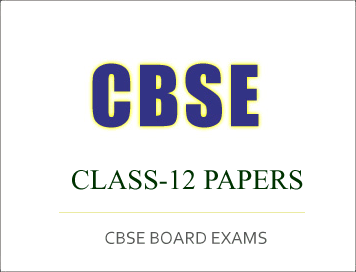CBSE Class-12 Question Papers for IOP/Comptt Examination 2017 : All India Scheme, Applied Physics
Disclaimer: This website is NOT associated with CBSE, for official website of CBSE visit - www.cbse.gov.in

CBSE Class-12 Question Papers for IOP/Comptt Examination 2017 :
All India Scheme, Applied Physics
CBSE Class-12 Question Papers for IOP/Comptt Examination 2017 : Applied Physics
APPLIED PHYSICS
(Theory)
Time allowed : 3 hours
Maximum Marks : 60
1. (a) State Coulomb’s Law in electrostatics and hence define the SI unit of charge.
Define the terms :
(i) Electric field, (ii) Electric field strength, at a point and (iii) Electric flux density.
OR
Calculate the magnitude of the point electric charge so that it has electric field strength of 2.0 NC–1 at a distance of 50 cm away from it.
(b) What is a ‘Solenoid’ ? Explain by drawing magnetic lines of force, why does a current carrying solenoid behave as a bar magnet. Write an expression for the magnetic field strength at the centre of a current carrying solenoid.
(c) What are ‘intrinsic semi-conductors’ ? How can these be made ‘extrinsic semiconductors’ ? What is the effect of temperature on the conductivity of an intrinsic semi-conductor ? Explain briefly.
2. (a) Name the factors on which the magnitude of the force experienced by an moving charge inside a magnetic field depend. Write the relation between the force and these factors. Name the rule used to determine the direction of this force.
OR
A current carrying conductor is placed at an angle of 30° to an uniform magnetic field of strength 1.0 × 10–3T. The length of the conductor inside the magnetic field is 2.0 m and the current flowing through it is 0.8 A. Calculate the
magnitude of the force experienced by it.
(b) What are ‘radio-isotopes’ ? Name any two such isotopes and one use of each.
(c) What is a ‘P-N junction’ ? How does it behave under forward and reverse biasings ? Explain by drawing the neat circuit diagtrams.
3. (a) Define the term ‘Capacitance’ of a capacitor and write its S.I. unit. Establish a relation for the total capacitance of ‘n’ capacitors connected in series.
(b) What is the meaning of the term ‘radiation-hazards’ ? Write four safety measures which can be taken against these.
(c) With the help of a labelled circuit diagram, explain the working of a ‘full wave rectifier’ using semi-conductor diodes. Draw input and output waveforms.
OR
Draw the atomic structures of ‘Ge’ and ‘Si’ atoms. How can these materials be made P-type and N-type semi-conductors ? Explain briefly.
4. (a) State Gauss’ theorem in electrostatics. Apply it to establish a relation for the electric field strength at a point near a long, charged, straight, conductor.
(b) Define the terms : ‘magnetic field strength’, ‘magnetic flux density’, and ‘permeability’ of magnetic materials. Write their S.I. units.
(c) Write two differences between ‘nuclear fission’ and ‘nuclear fusion’. Name one fissile material used as fuel in a nuclear reactor.
OR
Atoms of which element fuse together to produce large amount of energy in the Sun ?
Why cannot nuclear fusion energy be produced conveniently for commercial purposes ?